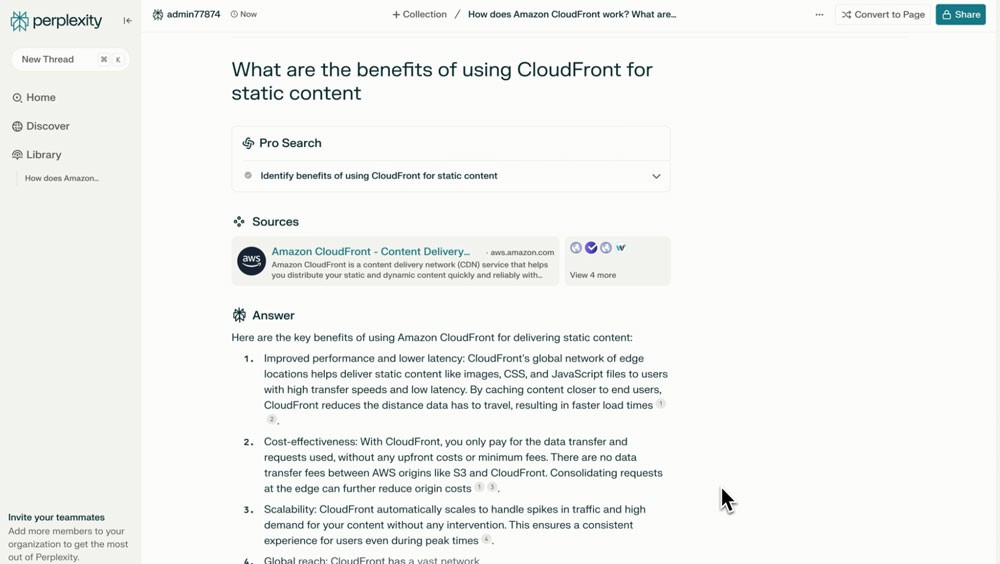Comment a été ce contenu ?
- Apprendre
- Reimagining search: Perplexity drives productivity with generative AI-powered answer engine
Reimagining search: Perplexity drives productivity with generative AI-powered answer engine
Search engines have become an indispensable part of our lives. We rely on them to find answers to pressing questions, like “who invented pizza?” and “what are the origins of the Joker card?” But they are also a powerful tool for conducting research, scanning the job market, accessing educational resources, and many other tasks that significantly impact our personal and professional lives.
Approximately 402.74 million terabytes of data are created every day—that’s roughly the equivalent of 137.5 billion hours’ worth of video. With so much information available to us, the ability to quickly find the right answers is essential for casual and professional users alike. But are traditional search engines still the fastest way to do that?
Some now believe that the growing influence of SEO has skewed how results are presented to us , raised questions around trust, and created a sub-optimal experience. Together with Amazon Web Services, Perplexity is redressing the balance. The company’s generative AI-powered solution, built on Amazon SageMaker, curates and synthesizes relevant information from trusted sources that is tailored to the user’s query. Now with the release of its Enterprise Pro offering, Perplexity is helping professional teams win back time and unlock significant productivity gains.
Delivering answers not results
Over the last 20 years, we’ve grown accustomed to a search experience defined by what Denis Yarats, Perplexity co-founder and CTO, refers to as “an interface of ten blue links.” A user enters a search query and is met with a list of links or documents from various sources. It’s then up to the user to click through to those results in the hopes of finding the information they’re looking for.

Perplexity changes that. “It’s the fastest way to get information on the internet,” says Yarats. “Fundamentally, it’s a tool that satisfies people’s curiosity.” Unlike traditional search engines, Perplexity provides users with a single synthesized answer to their queries, based on real-time information, and complete with citations from trusted outlets and publications. It also curates a list of relevant follow up questions if a user wants to dive deeper into a topic. “This saves users a lot of time, and the answers we provide are very accurate, factually grounded, and trustworthy.”
15 million users in just 2 years
Perplexity was founded in 2022 by four experienced engineers: Aravind Srinivas, Denis Yarats, Johnny Ho, and Andy Konwinski. Prior to Perplexity, the quartet had been working at the edge of technological innovation and research: Srinivas worked as an AI researcher at OpenAI; Yarats was an AI research scientist at Meta; Ho had previously worked as an engineer at Quora; and Konwinski was among the founding team at Databricks.
Having initially experimented with algorithms capable of translating natural language into SQL, the team soon re-focused their efforts towards combining traditional search index with large language models. Fast-forward to today and Perplexity answers more than 250 million queries a month and is valued at over $1 billion USD.
Growth built on proven technology and trusted expertise
Perplexity has been working with AWS from day one. “When we started out, we had very limited resources,” says Yarats. To overcome these limitations, the company enrolled in the AWS Activate program, which provides startups with technical support, architecture guidance, and up to $100,000 USD in AWS credits to help them build, launch, and scale at speed. “We received a lot of compute credits that helped us to develop Perplexity at low infrastructure costs; it was an instrumental piece of our success story.”

He continues: “Perplexity is fully based on AWS. We are using pretty much every technology that is available there, starting from DNS and web servers to GPU clusters, and storage services like Amazon Simple Storage Service (Amazon S3).” As Perplexity’s user base grows, AWS is helping to enable the company to scale its computational resources to meet demand on infrastructure backed by vast security services and features. When it comes to generative AI, AWS gives all customers control over their data across the entire AI lifecycle, including preparation, training, and inferencing.
“Generative AI is at our core. We use this technology not only to understand the user's questions better but also synthesize answers for them,” says Yarats. “AWS is a great partner for AI startups because they understand at the core how difficult it is to tackle generative AI.” He continues: “We are developing at the forefront of this technology and stumble upon very difficult and novel questions that require specialized expertise. AWS provides us with that expertise.”
Proven methodologies and frameworks for success
The AWS Startups team comprises over a thousand global experts—including ex-founders, CTOs, and investors—who understand the unique challenges faced by disruptors. Yarats explains: “we needed a trusted partner that could deliver secure, scalable and elastic infrastructure—and that’s what AWS excels at. I vividly remember when we first started working with AWS, we had a Slack channel with around fifty people from their team ready to help us whenever we needed it.”
Marcos Boaglio, Senior Machine Learning Solutions Architect, AWS, adds: “One of our most important leadership principles is customer obsession. We start by connecting with the customer, understanding their needs and the problem they want to solve, and then we work backwards towards the solution.” Yarats adds: “As a small startup you really need that kind of help as you have limited resources to tackle those problems. It's obvious that AWS cares deeply about innovation at its core, it’s part of their mission.”
A key part of the support provided by AWS Startups is helping to ensure that disruptors like Perplexity can innovate on secure, high-performing, resilient, and efficient infrastructure. That’s where the AWS Well-Architected Tool’s framework comes into play. “AWS Well-Architected is a collection of best practices based on multiple key pillars including: Security, Cost optimization, and Operational excellence,” says Boaglio. “We conduct periodic Well-Architected reviews with Perplexity to ensure that these best practices are being applied, uncover opportunities to reduce costs, and make technical recommendations.”
It's this level of support that has helped Perplexity maintain momentum and develop a professional-grade version of its tool—Enterprise Pro.
Time-saving intelligence
Enterprise Pro expands on Perplexity’s core capabilities and has already been adopted by the likes of Databricks, HP, Zoom, and the Cleveland Cavaliers. It’s designed to support professional users working on demanding tasks like academic research and data analysis, simulations, and code interpretation. “The average query on Perplexity is around ten words, which is much, much longer than traditional search engines,” says Yarats.

“One of the key features generative AI enables is conversational search, allowing our users to follow up on their original queries, receive suggestions, and dive deeper,” Yarats explains. This helps professional teams quickly find the answers they’re looking for and experience an uptick in productivity. Enterprise Pro can even provide users with helpful pointers on how to refine their queries.
For example, the Cleveland Cavaliers are using Enterprise Pro to close knowledge gaps, quickly on-board new staff and stakeholders, and boost daily productivity across multiple teams. On average, this is enabling employees to claim back over ten hours every week. That time can now be spent on more pressing business priorities instead of mundane, repetitive search tasks.
Reimagining what’s possible with generative AI
Perplexity Enterprise Pro leverages leading generative AI models. That includes its own large language models, developed using Amazon SageMaker. “One of the reasons we decided to go with AWS is because they provide the most advanced technologies to enable generative AI,” says Yarats. “We’ve been working closely with the Amazon Bedrock team to understand best practices to enable security, scale, and privacy for our users. We are also one of the first customers to use Amazon SageMaker HyperPod, which we are using to train and serve our models.”
SageMaker HyperPod takes the heavy lifting out of optimizing machine learning (ML) infrastructure used for training foundation models (FMs). It enables customers to automatically split training workloads across thousands of accelerators, so workloads can be processed in parallel for improved model performance. Boaglio explains: “It’s a platform that helps customers train and fine-tune large language models. It essentially optimizes every single thing that you use for training your models.”

Yarats explains: “SageMaker HyperPod allows us to easily train very large and long-running jobs without having to worry about things like hardware issues.” If a hardware failure occurs during training, it’s automatically detected, and the faulty instance is either repaired or replaced as needed—no manual intervention required. This enables startups like Perplexity to reduce the time needed to fine-tune foundation models by up to 40%.
“90% of AWS products are created as a direct result of customer feedback,” says Boaglio. “SageMaker HyperPod is one of the clearest examples of this. It was created to solve a specific problem, a problem Perplexity was experiencing.” Placing emerging technologies in the hands of innovative startups is a key part of how AWS develops its products. “SageMaker Hyperpod is an evolving product, and the Perplexity team has been very active in the whole process, helping us test and providing feedback.”
Frictionless customer experience that powers productivity
“Perplexity is an answer engine, not a search engine,” says Yarats. Together with AWS, Perplexity is reimagining how businesses find answers, research, and collaborate. Gone are the days of ten blue links. With Enterprise Pro, professionals can access the information needed to do their jobs effectively at speeds that would have previously been impossible.
Going forward, Perplexity will continue to innovate at the forefront of generative AI. “What excites me the most about Perplexity is that the team is always experimenting,” says Boaglio. “Whether it’s new models, or tweaking different features to make their product even faster and more accurate. It’s impressive.”
“I’m very excited about developing a much more advanced version of Perplexity, where you can not only ask questions, but also give tasks and actions for the AI to perform,” says Yarats. “I believe AWS is going to be the perfect partner to reach that future, because it will require a lot of expertise, computing power, and cutting-edge infrastructure—I’m confident AWS can deliver that.”

Denis Yarats
Denis Yarats est le cofondateur et le directeur technique de Perplexity AI depuis 2022. Il est titulaire d’un doctorat en intelligence artificielle de l’université de New York. Avant de cofonder Perplexity, Denis a travaillé comme chercheur en IA chez Facebook AI Research de juin 2016 à juillet 2022. De septembre 2013 à juin 2016, Denis a occupé un poste d’ingénieur en apprentissage automatique pour le personnel chez Quora. Il a été le responsable technique de l’équipe de machine learning, contribuant de manière significative aux capacités d’IA de la plateforme. Sa vaste expérience et son expertise font de lui un acteur clé dans les avancées continues du secteur de l’IA.

Marcos Boaglio
Marcos est un architecte senior des solutions de machine learning AWS établi en Floride, aux États-Unis. À ce titre, il est chargé de guider et d’aider les start-ups américaines d’IA générative dans leur stratégie à destination du cloud, en fournissant des conseils sur la manière de résoudre les problèmes à haut risque et d’optimiser leurs charges de travail de machine learning. Il possède plus de 25 ans d’expérience dans le domaine de la technologie, notamment dans le développement de solutions cloud, le machine learning, le développement de logiciels et l’infrastructure de centres de données.
Comment a été ce contenu ?